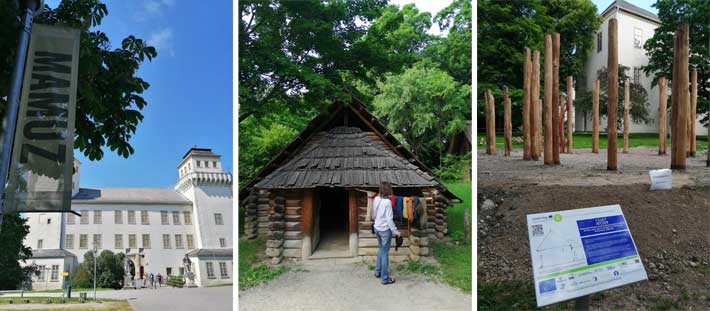
beautyme collections culture cuisine motor music search
8 June 2021
Exploration tour tip: The beginnings of the making of textiles reconstructed on basis of findings of scientific research and experimental archaeology at the outdoor park of MAMUZ Schloss Asparn in Lower Austria
 Recently, Fashion.at visited one of the museums of MAMUZ in Lower Austria at the federal state's so-called 'Weinviertel' at Schloss Asparn at the Zaya. Since 2014, the collections and research activities of the museum of prehistory 'Urgeschichtemuseum Niederösterreich Asparn/Zaya' and the museum centre 'MZM Museumszentrum Mistelbach' run under the new name MAMUZ which might sound in German similar to 'mammut' (mammoth, the extinct elephant species lived until around 4.000 years ago). The reconstruction of such an extinct animal is placed in life-size by the museum makers at the courtyard of the palace Schloss Asparn. The mammoth appears to be ready to trumpet for the welcome of visitors of the outdoor park. Some visitors might see the extinct animal also as a memorial of climate change from a long time past period of the planet.
Recently, Fashion.at visited one of the museums of MAMUZ in Lower Austria at the federal state's so-called 'Weinviertel' at Schloss Asparn at the Zaya. Since 2014, the collections and research activities of the museum of prehistory 'Urgeschichtemuseum Niederösterreich Asparn/Zaya' and the museum centre 'MZM Museumszentrum Mistelbach' run under the new name MAMUZ which might sound in German similar to 'mammut' (mammoth, the extinct elephant species lived until around 4.000 years ago). The reconstruction of such an extinct animal is placed in life-size by the museum makers at the courtyard of the palace Schloss Asparn. The mammoth appears to be ready to trumpet for the welcome of visitors of the outdoor park. Some visitors might see the extinct animal also as a memorial of climate change from a long time past period of the planet.
Images: Snapshots from Fashion.at's visit of MAMUZ Schloss Asparn/Zaya.
The exploration of living worlds starts with tipis (tents, originally made with animal skin and wood) of the Paleolithic hunter and collector culture. The first tracks of textile production can be observed already at the next living world with an accessible quasi-'furnished' building which was reconstructed after a Neolithic Age settlement from ca. 5600/5500 BC found in the region of Schwechat in Lower Austria. Weaving is after stone and wood works the longest practised craft and can be dated back to the Neolithic. At the Bronze Age settlement (ca. 2200 BC), the museum researchers provide insights into how textiles were processed with examples of the colors achieved through natural dyes (picture on this page in the middle; inside the house, it's shown how textiles were dyed). A warp-weighted loom can be found at the Iron Age settlement from ca. 800 BC. The settlement is the largest and reconstructed after finds from various locations in Lower Austria. One center piece of the Iron Age living world is the Celtic shrine showing the god Cernunnos. The prehistory (Palaeolithic Age, the Neolithic Age, Metal Age) outdoor tour ends with the construction site of an early medieval church (picture right). The reconstruction after archaeological findings of an around 1000-year-old church started in May 2021, completion planned for October.
Inside the palace, the curators introduce with exhibited textile, jewelry,... items into the scientific field 'Experimental Archaeology' which can be described as a combination of research and crafts for putting together pieces and knowledge from archeological findings for proving for example if its plausible respectively possible that textiles from materials (wool, plants) were woven or dyed and in which colors, when and with which means (loom, dyed with known and at that time existing plants,...).
Fashion.at recommendation for getting professional insights into the early beginnings of arts & crafts over a time period of several thousands of years: Guided tours in German language are available, on request also in English, Czech and Slovak.